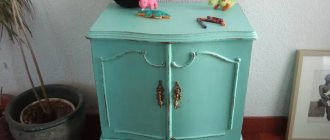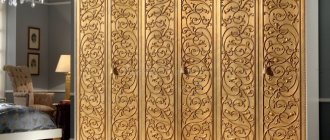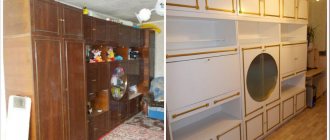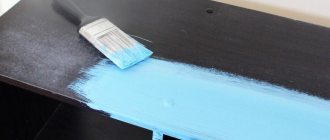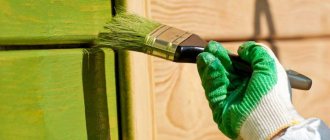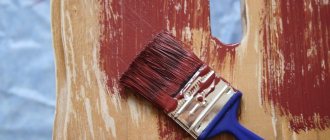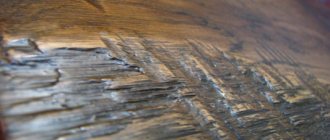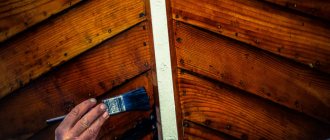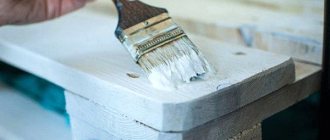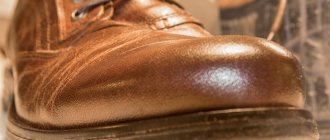The need to repaint a furniture set usually arises when its appearance no longer suits the owner due to various reasons, ranging from cracked coating to outdated style. This is where cosmetic restoration of a household item comes in handy. Updating the paintwork will not only extend the service life of the product, but will also bring fresh notes to the overall decor of the home. And if you also choose a special paint, you can effectively protect the surface from future accidental mechanical damage.
When does coloring make sense?
After you take a closer look at the price tags in furniture stores, you begin to think about alternative ways to update your interior. A good way to update would be to repaint existing furnishings. There are several reasons why people think about painting furniture and begin to study the issue in detail:
- I would like to update the furniture in my dacha. Most country house sets are made up of outdated furniture of different styles and colors. The update will help bring all items to a single style, making the interior harmonious and cozy.
- It's a shame to throw away your old headset. Many sets left over from Soviet times are durable and can last for decades. But their surface has long lost its attractiveness, and the objects themselves look obsolete; Restoration and painting (possibly with a color change) will help extend their life.
How to refresh an old item Source aviarydecor.com
- The house has an inherited rare wardrobe or retro chest of drawers. Antique furniture is valuable for its original appearance, often more refined than modern models, but its appearance is far from perfect. Skillful restoration will transform an old item beyond recognition and make it a decoration for any living room or bedroom.
- You want to refresh the interior, but you are not mentally prepared for a full renovation. In this case, point changes are used. They often change the color of one wall, make it an accent wall, and purchase new textiles and lamps. An effective way would be to repaint furniture in a new, sometimes unexpected color: when a brown cabinet turns white or olive, the interior is transformed beyond recognition.
- I want to change my style. They resort to artificial aging of facades when they want to decorate the interior with vintage notes (for example, Provence or shabby chic). A chest of drawers or a wardrobe begins to resemble an antique thanks to a special painting technology. A decorative layer with noble cracks can be obtained in several ways.
Nightstand with aged effect Source luniqueblog.com
Varnish coating
To give painted furniture the necessary shine, the surfaces should be varnished. To do this you will need:
You can paint furniture with a brush or spray.
- acrylic lacquer;
- a brush for working with varnish or a foam sponge;
- latex gloves.
After the paint has completely dried, we begin to apply the varnish coating. To do this, we use acrylic varnish, which we apply to wooden parts with a foam sponge or brush in one direction. The varnish should be applied in 2-3 layers.
After applying each layer, you must wait until it dries according to the instructions for use.
What we paint: getting ready for the process
Before wondering how to repaint furniture a different color, you need to determine what material you will have to deal with. Solid wood furniture is quite rare; It is easy to paint a prepared wooden surface. The only problem that may arise after applying paint or varnish is the raising of pile. To prevent this, the coating is sanded after the first priming.
More often, Soviet-made items made from chipboard and MDF need updating. To work with them, you should stock up on a respirator, gloves, and provide ventilation. The direction of action is determined by the type of particle board:
- Painted. You can remove a layer of paint (as well as varnish) using a solvent; The procedure will take more than one hour, plus you will have to spend money on chemicals. There is an alternative cleaning option - a spatula and a hair dryer.
Fashionable white Source kammerat.co
- Lacquered. Repainting old varnished items is harder than any other. According to the technology, the varnish was applied in several layers, and its complete removal can take a lot of time. If the surface has scratches or other damage, it is much easier to polish it while maintaining the original color.
- Laminated. The technology for making furniture from laminated chipboard is used in modern production. The surface is covered with a polymer film, creating a durable and reliable layer. The process of restoring items made from laminated chipboard is very difficult; the coating cannot be completely removed, and there is a high risk of damaging the base material.
Fashionable black Source pinimg.com
- Laminated. The laminating process involves applying glue to chipboard or MDF, followed by pressing on decorative film, budget material on a paper or fleece basis. The paper covering is the most unreliable, it is not difficult to clean it, but in addition it is necessary to remove the adhesive layer. After stripping the glue, the item is ready to apply new decor.
- Veneered. Products made from chipboard covered with natural wood veneer are high-quality products and an alternative to things made from solid natural wood. The decorative layer is not removed, so restoration is carried out only with the help of stain and varnish.
Yellow as an interior accent Source foter.com
See also: Catalog of companies that specialize in paints and varnishes and related work
DIY furniture painting step by step
Even with minimal experience, it is possible to update a furniture set by painting. Below we will look step by step how to do this.
Furniture disassembly
This is the most important stage in preparing furniture for painting. All mechanisms are repaired or replaced, then the object itself is disassembled: drawers are removed, handles and hinged parts are removed. This will allow you to paint all surfaces evenly and neatly. Decorative elements that could not be removed, mirrors, and fittings are sealed with masking tape, which will protect against accidental contact with paint or varnish. When the restoration work is completed, the tape is removed.
Removing old coating
Before painting wooden furniture, the surfaces should be cleaned of the old paint layer.
To do this, use a spatula and sandpaper. These tools help remove coatings from surfaces, but the process is quite lengthy. Alternatively, you can use a sanding machine. Other ways to remove paint:
- Construction hairdryer. The surfaces are heated, under a stream of warm air the paint layer becomes soft and can be easily removed with a spatula.
- Grinder with a metal brush. It will remove the layer quickly, but it is important to work very carefully so as not to damage the wood.
- Wash. Sold in automotive supply stores. Apply to the surface, after the paint begins to bubble due to the reaction, it is removed with a spatula.
Regardless of the chosen method, after processing the parts are sanded with sandpaper - first with coarse grain, then with fine grain. Particular attention is paid to the ends and decorative fragments. You can remove dust with a regular vacuum cleaner.
Primer and putty
These are the next steps in preparing furniture for painting yourself. Primer - application of a composition to the surface to evenly distribute the paint and ensure normal adhesion of the composition to the surface.
Procedure:
- Apply a primer (preferably acrylic based) to facades and other surfaces.
- Leave until completely dry.
- Degrease with alcohol.
Putty will help disguise damage, defects, chips and cracks. It is applied in a thin layer with a rubber spatula. In case of significant damage, application in two layers is allowed.
Furniture surface painting techniques
Before implementing this stage, you should cover the floor and furniture located nearby with newspaper or film. It is better to work in a ventilated room, after wearing personal protective equipment. To prevent the appearance of unpainted areas and drips, paint should be sprayed at a distance of about 30 cm, movements should be smooth.
Paint from cans is first poured into a tray and applied with a roller. Small elements are painted with a thin brush. To get a rich shade, you don't need to apply a thick layer. You need to wait until it dries, after which you need to paint it again.
Surfaces are treated with varnish in a similar way. This stage begins after the paint has completely dried.
There are a number of techniques for painting furniture:
- Toning. Transparent varnish is used for implementation. Apply a thin layer to the surface, renewing it.
- Complete repainting. The composition is applied in several layers.
- Varnishing. Finishing to give a matte or glossy effect. The main task is protection from mechanical damage and negative external influences.
Surface preparation
The preparation process may require all or only some of the following procedures:
- Drying and removing mold. You can’t do without them if the old cabinet has spent many years in the barn; The paint will only adhere well to dry wood. If there are areas affected by mold on the surface, they are washed with water, dried, and then sanded. At the end, the tree is coated with an antifungal drug, covering neighboring areas.
- Processing of knots. This is a problem with almost any new wood. The knots release resin, which prevents the paint from adhering tightly. The resin is removed with a spatula; the knot area can be preheated with a technical hair dryer. Then the area is sanded with sandpaper and further treated with cellulose (or ammonia) solvent.
Sanding Source saymedia-content.com
- Removing the coating. If the old coating (varnish, paint) is partially preserved, it is sanded with sandpaper. If it is cracked or peeling, heating with a technical hairdryer followed by scraping with a spatula will help. The varnish can be pre-softened using a paint remover.
- Putty. It is needed to level the surface and remove chips and cracks. Use a special putty for wood (water-based) to fill the uneven areas. Then the application area is carefully sanded with fine-grained sandpaper.
- Degreasing. The wooden surface should not only be dry and smooth, but also frequent, without grease stains or traces of resin. Extraction gasoline or nitro solvent will help wash away dirt.
- Primer. It reduces paint consumption, preventing it from being absorbed into the wooden base, and at the same time improves the adhesion (adhesion) of the layers. Before applying the primer (a colorless primer for wood or drying oil is suitable), the surface is cleaned with a brush or vacuum cleaner.
Filling defects Source pitmebel.ru
Recommendations for working with paint
To work with acrylic paint, it is better to use synthetic brushes. Acrylic dissolves in water, and brushes and palettes are washed with water. After drying, acrylic becomes insoluble and can ruin brushes if they are not thoroughly washed immediately. When this is not possible during work, let the brush be in a jar of water. After finishing your work, be sure to wash and dry your brushes.
When painting old furniture with your own hands, it is important to know that dried acrylic cannot be removed with water; it can hardly be scraped off and sanded.
Recommendations for working with acrylic paint:
- If you stain your clothes, the paint must be washed off immediately, before it dries, by rinsing the fabric in plenty of water.
- After work, you should tightly close the tube or jar, otherwise the paint will dry out. Pre-clean the neck of any remaining paint so that you can open the package without effort next time.
- Once applied to the surface, water evaporates from acrylic paint and it becomes frost-resistant. But leaving paint packaging (cans and tubes) at subzero temperatures is strictly prohibited; the paint will deteriorate, losing all its properties.
The best way to repaint furniture
The choice of paint and varnish products on the construction market is amazing. The owner of an old cabinet, deciding how to paint chipboard furniture at home in white (or any other) color, will first of all have to decide on the choice of composition.
You can use stain if you only want to tint the material (usually it is chosen for veneered furniture). The varnish is applied in two ways. Usually the varnish layer is the final one; it secures and protects the bottom decorative layer, making it resistant to moisture. Varnish, like wax, can be used independently; this helps maintain the natural wood texture.
Tinting Source pinimg.com
Features of painting various types of furniture
Each material has its own subtleties and nuances that should be taken into account when working.
Painting MDF furniture
The surfaces are freed from the old coating, cleaned and degreased. Next, apply a layer of acrylic primer. It will help level the surfaces, close all pores and provide an even layer of paint. The coloring composition can be applied in various ways:
- spray can;
- spray gun;
- roller;
- with a brush.
If, when painting MDF furniture at home, it is necessary to obtain a rich, deep tone, several layers are made, each of which is dried. The final stage is varnishing. It will add shine and protect against adverse external factors.
Painting chipboard furniture
The first steps in this option of painting furniture are standard - the surfaces are freed from the old coating, sanded, covered with a layer of primer, and, if necessary, putty. The peculiarity of working with such a surface is that the material is covered with veneer or varnish, laminated, or laminated. Pre-treatment depends on the type of surface.
Painted chipboards are subjected to heat treatment (for example, with a construction hair dryer). Soft paint can be easily removed with a spatula. If you don't have a hairdryer, you can use an iron. The surfaces are ironed through the foil, after which the paint can be removed very easily. The veneer or laminated layer is removed with sandpaper. Dust is swept away with a brush; you should not wipe the surface with a rag or sponge - the dust will get into the pores of the wood.
To paint chipboard furniture, you can use alkyd, oil or acrylic paints. The choice depends on the characteristics of the room. In the kitchen and bathroom, alkyd compounds that are resistant to moisture and microorganisms are best suited. For bedrooms and children's rooms, choose acrylic that does not have an unpleasant odor.
Features of painting furniture made of chipboard with your own hands:
- After applying and drying the first layer, you should carefully smooth out all the unevenness and roughness with fine-grain sandpaper. Then apply a second layer.
- Varnishes are also used for chipboard; they will protect the surfaces from moisture and mold. Alkyd, alcohol, and epoxy compounds are suitable.
If you have to paint a cabinet in an unassembled state, you need to work very slowly and in small layers, this will help to avoid drips.
Painting natural wood furniture
Most often, instead of painting furniture, it is treated with varnish. But if the surfaces previously had a coloring composition, it should be renewed. Preliminary preparation is standard, the only caveat is that natural material will require so-called “lint removal.” To do this, the surfaces are covered with a layer of stain or other wet composition, such as varnish.
After preparation, a layer of paint is applied. You can use any type of furniture painting (tinting, staining, varnishing).
Stain is used for tinting; it perfectly emphasizes the beautiful texture of natural wood. Can be wax, alcohol, water or oil.
Technology for painting solid wood furniture with stain:
- The composition is applied with a flute brush.
- If you need to make two layers, dry each thoroughly.
It is important to distribute the composition evenly over the surface, otherwise stains will appear.
Paint options for painting wood furniture:
- If the item is located in a room with high humidity, a water-based one is suitable.
- The best option for painting children's furniture is acrylic. It is environmentally friendly, odorless, and dries quickly.
- Furniture compositions must be labeled with the “Eco Label” designation, this indicates safety.
- Latex and acrylic compositions are suitable for the bathroom. For the kitchen - water-based, odorless.
- Previously, painting wooden furniture with oil was considered the most successful option, but this composition takes a long time to dry and has an unpleasant odor. It has been replaced by modern silicone paints.
The type of wood affects how much compound is needed. Cedar, pine and fir absorb paint best. Birch, maple, and beech are much more economical.
Variety of colors
The color range of paints on the construction market is endlessly varied. If you cannot find a suitable shade, you can always resort to tinting, a technology that allows you to obtain the desired tone. Self-tinting is fraught with pitfalls: if there is not enough paint, it is almost impossible to reproduce the same shade.
When using different compositions, the surface type has different degrees of gloss: matte, semi-matte (satin, silky-matte), glossy. The following types of dyes are suitable for furniture decoration:
- Oily. The paint forms a dense matte layer on the surface, the shade is saturated. A significant disadvantage is the long drying time, coupled with an unpleasant odor that lasts for some time after drying. It is better to work with the oil composition outdoors or in non-residential premises.
Chair update Source ytimg.com
- Acrylic. Furniture acrylic paints are mostly matte, close to natural shades. For anyone wondering how to spray paint white chipboard furniture, water-based acrylic is the ideal choice. It will lie flat and dry quickly, without odor or health consequences. To paint laminated chipboard you will need a composition with increased adhesion, and you should not dilute it with water.
- Alkyd (enamel). Alkyd enamel is harmless, economical in use and does not turn yellow over time. The surface dries quickly and becomes glossy. If the furniture has metal parts, they will be protected from corrosion. Fresh paint has a specific smell.
- Latex (silicone). Water-based paint with artificial latex is environmentally friendly, UV-resistant, and dries quickly (within an hour). The composition is often used for the restoration of veneer furniture. The disadvantage is its high cost, as well as the need for careful surface preparation before application.
Coloring Source diy.obi.ru
How to choose paint for furniture
It is necessary to take into account the composition of the surface to be coated, the service life and decorative qualities of the item. This will help you avoid mistakes and make the right choice of material.
For children's furniture, you should select acrylic and water-dispersion paints, since from an environmental point of view they are the safest for human health because they do not contain harmful components.
The same goes for kitchen items. The coating will not allow grease and other contaminants to be absorbed into the surface, which will greatly facilitate maintenance.
Principles for choosing paint
An important selection criterion is the place where the furniture will be used. From this point of view, water-based compositions are chosen for home furnishings. They are harmless to health, resistant to abrasion, and the surface painted with them “breathes.”
They act differently if the restored sofa or armchair is planned to be placed on an open veranda. When considering different options for painting a chipboard chest of drawers white, the choice is made in favor of paints with high elasticity. Drying oil-based paints may be a suitable solution, but they take a long time to dry, and under the rays of the sun the oil layer may crack over time.
On the terrace Source pinimg.com
For furniture intended for outdoor use, other compositions with high elasticity are also suitable: alkyd-oil and alkyd. Water-based wood dyes are also intended for exterior use; they are environmentally friendly and preserve the integrity of the layer during changes in temperature and humidity.
Home furniture can be repainted using acrylic, oil or alkyd paint. A composition based on drying oil is affordable, but it is advisable to choose it for working in a vintage style. Based on the totality of its characteristics, acrylic paint is considered the best, and alkyd enamel surpasses it in terms of price/quality ratio and is therefore the golden mean.
Vintage chair decor Source in-stadtmagazine.de
Mixing acrylic paints: table and rules
When painting furniture with acrylic paint, you can immediately buy paint of the required color or shade. Or you can learn how to mix acrylic paints yourself by purchasing only the base white color. But to paint and decorate furniture, you will in any case have to mix the paints yourself to achieve the desired tone.
Let's look at the rules and the process of mixing acrylic paints using the example of obtaining ivory paint. The volume of the mixture components is indicated conditionally so that the proportions are clear. It is impossible to give an exact recipe, since each manufacturer of artistic paints has its own color saturation of pigments, and paints with the same name rarely match in color.
To mix, take paints: white 96%, light ocher 2%, cadmium yellow 1%, lemon 1%.
- Start mixing, gradually introducing ocher into the white with a brush, then all the other colors.
- While mixing, do color tests on a sheet of white paper.
- Based on the samples you have made, gradually add white paint or other components of the batch.
- Experiment with the ingredients, achieving different shades, but do not forget that acrylic paints darken after drying, changing tone.
When mixing paints yourself, use burnt umber instead of black paint to create more organic, subtle dark shades.
Below is a visual table for mixing acrylic paints with which you can easily experiment and create new colors:
How to paint correctly: secrets of painting and decor
Tips on how to repaint old furniture white step by step include all the important steps, from surface preparation and paint selection to painting technology. However, important little things that simplify the process and improve the result are often overlooked. The following tips will undoubtedly be useful:
- It is useful to stock up on several brushes of different sizes (thicknesses). It is convenient to handle large surfaces and decorative elements using a spray gun.
- The wooden surface is painted along the grain with smooth movements, the brush is lowered into the jar no more than a third.
- If there are fittings on the furniture façade (handles, locks), they are removed during painting or wrapped with mounting tape.
In the kitchen with a touch of Provence Source archidea.com.ua
- Aerosol paint is used uneconomically, for example, when painting a chair. But it is convenient to work with fittings or decorative elements. Color is applied to small details with an aerosol faster and more evenly than with a brush.
- Using spray paint and a stencil, you can apply a pattern to a wooden surface. For example, a plastic lace napkin is suitable as a stencil.
- Furniture in retro or Provence style can be decorated with decorative stucco molding made of polystyrene foam or polyurethane. The decor is attached with wood glue; paint the product after the glue has dried.
- Masking tape is a useful addition to the job. It will protect the already painted part from getting another dye.
Fittings are important for style Source mydecorative.com
Characteristics and parameters of paintwork materials
Paint and varnish materials have a huge variety of properties - some are odorless (extremely useful when painting children's rooms), others are convenient for covering particle structures. There are quite a lot of nuances, but it is potentially necessary to pay close attention to the following:
- Acrylate paints are diluted with water, however, they have good adhesion, so they can even be used to paint chipboard. The result will be no worse than that of alkyd, because upon completion a wear-resistant film with high-quality adhesion will be formed.
- It is better to apply primer paints after finishing paints - this will ensure better fixation between the finishing composition and the load-bearing surface.
- Latex samples are distinguished by the fact that, although they are diluted with water, they are capable of drying quickly.
- It is worth mentioning that there is a special classification of base paints. Base “A” includes the types used for making light colors. Base “C” includes types used to obtain a dark color (they necessarily include a tinting paste). The EP base includes various stains and wood-protective varnishes.
IMPORTANT! It is possible to find latex paint on sale that does not require the use of solvents. This means that it will not have any odor. This material is perfect for a children's room or for rooms where people with allergies live.
Briefly about the main thing
You can give obsolete furniture a new life by painting it a different color. The method is also suitable if you want to change your boring interior without going into renovations. Before painting, furniture must be prepared and the type of surface determined.
Preparation is a multi-step process, and skipping its stages is highly undesirable. Different types of paint and varnish products are used for repainting. Stain tints the material, varnish and wax complete the process. The main composition, paint, is chosen based on its performance characteristics. To ensure that the paint lays evenly, surface defects must first be repaired and work in good lighting.
Ratings 0
What you will need
For work you will need the following tools and materials:
- A dense roller (or a pen attachment with two or three replaceable rollers). The width is chosen depending on the size of the cabinet (chest of drawers), on average 10-15 cm. A roller will help to evenly roll out the paint on a large surface, and the result will be good the first time. Select the tray according to the size of the roller.
- Two or three soft brushes of different sizes with artificial bristles. Hard bristles are not recommended as they will leave streaks that are difficult to get rid of. Brushes are needed for painting elements of complex shapes, where a roller cannot cope.
- Screwdriver Set. You will have to remove the fittings and most likely disassemble the furniture. The work will be more comfortable and of higher quality if you simply remove the doors.
- Masking tape. You will need it to protect small parts that cannot be removed. For example, if there are built-in lamps in the closet, they are removed, but left hanging and protected with tape.
A tool you can’t do without Source pinimg.com
- Sandpaper (sandpaper) of different formats: fine (soft) and coarse.
- New hardware if you are going to change the style of the cabinet or make it more original. The easiest way to find suitable handles is in large and specialized online stores - the choice of accessories there is truly limitless.
- Paint and varnish materials: paint, varnish, and degreasing solvent.
- You always need rags (napkins); polyethylene comes in handy to protect the surrounding area from paint.
Optionally the following items can be used:
- Sander, safety glasses and gloves.
- Spatula and putty.
- If a large area will be treated, a sprayer is convenient.
Applying varnish to a countertop Source premium.vgc.no
Preparing furniture: where to start
Preparation begins with removing dirt, old stains and odors. The easiest way to do this is with a sponge soaked in washing powder or soap solution. After washing, stubborn stains remain, which can be removed with vinegar, acetone or white spirit. To make it convenient to work, move the furniture away from the wall, put on a protective mask and gloves, and do not forget to ventilate the room.
After washing, the surface is allowed to dry, then the old coating is removed. They do this in one of the following ways:
- Mechanical. The fastest way to do this is with a grinder and a wide spatula. In hard-to-reach places, remove the varnish coating using a flat-tip screwdriver.
- Chemical. To remove old polish, special solvent-based removers are used. The composition is applied to the surface of the cabinet for the time specified in the instructions. Once the reaction is complete, the remaining material is removed with coarse sandpaper or a spatula.
Design in fashionable white color Source gidpokraske.ru
- Thermal. The old varnish or film coating peels off and is easily removed after heating with a hair dryer. If the film does not lend itself, it is left and painted over it, having first sanded it.
After the old coating is removed, the surface is lightly sanded to remove any small residues. If the furniture is wooden, sanding is carried out in the direction of the grain. The task is performed in three steps: first use coarse-grained sandpaper, then use medium-grained sandpaper, and finally use fine-grained sandpaper.
At this stage, the cabinet is carefully inspected so as not to miss any defect. If the item is large, it is more convenient to dismantle it; It is easier to paint individual parts, and the result is of higher quality.
